Grevillea ‘Bonfire’

Grevillea ‘Bonfire’ is said to be an upright shrub reaching a height of two metres. We know of a group of “Bonfires”, in a garden, that are about five metres tall. The leaves are dark green and narrowly divided. New growth has a bronze colour.
Grevillea beadleana
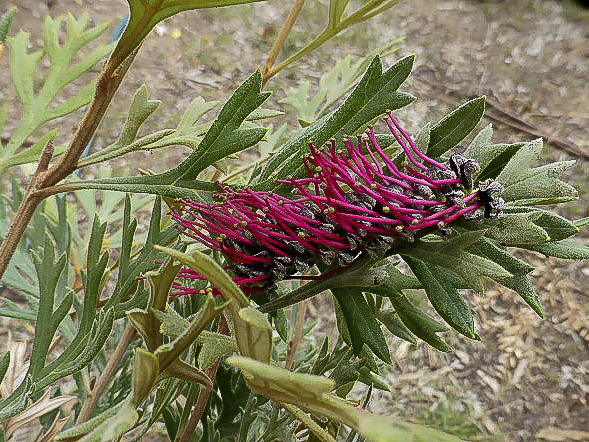
Grevillea beadleana is a beautiful, dense, spreading shrub with soft, divided, grey-green leaves. The toothbrush-shaped flowers are dark red, almost black in colour. Blooms are carried for most of the year and are rich in nectar.
Grevillea arenaria

Grevillea arenaria ssp. arenaria is a medium to tall shrub that reaches a height between three to four metres in our cold climate garden. The leaves are light green, soft and have a velvety feel. The flowers may be pink, red or orange with a green or yellow base.
Grevillea ‘Apricot Glow’
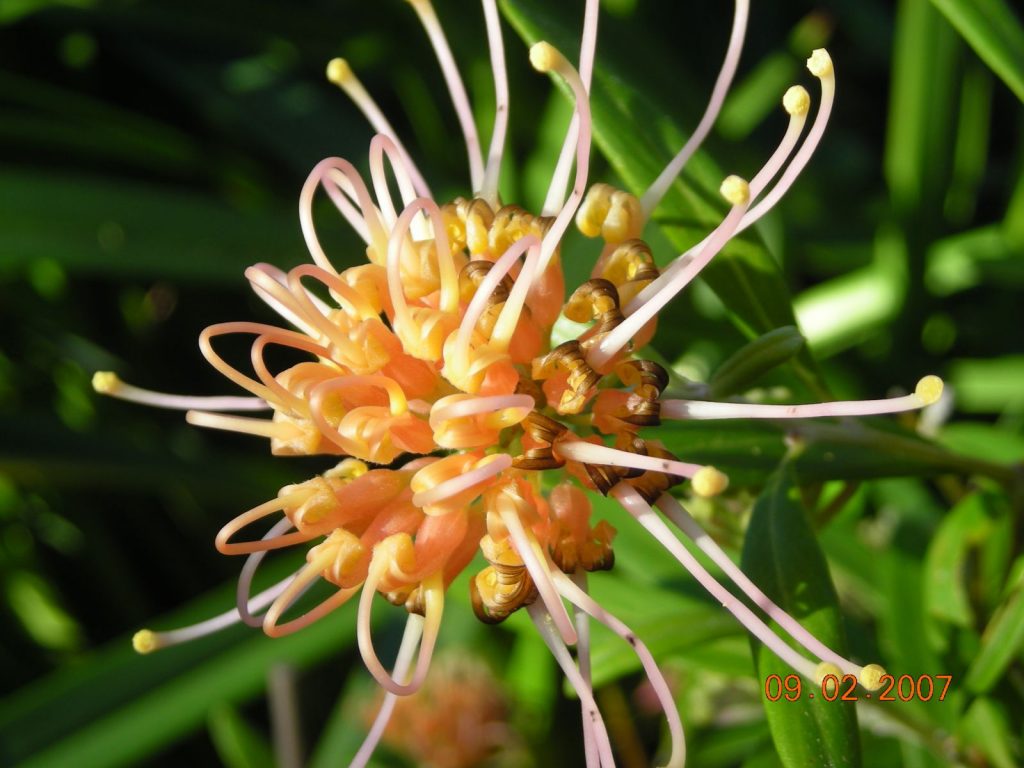
Grevillea ‘Apricot Glow’ is said to be a cultivar of G. olivacea, a native of Western Australia. Grevillea ‘Apricot Glow’ is a tall shrub that will reach a height of three metres. Leaves are deep green, oval and similar in appearance to those of the exotic olive.
Grevillea ‘Apricot Charm’
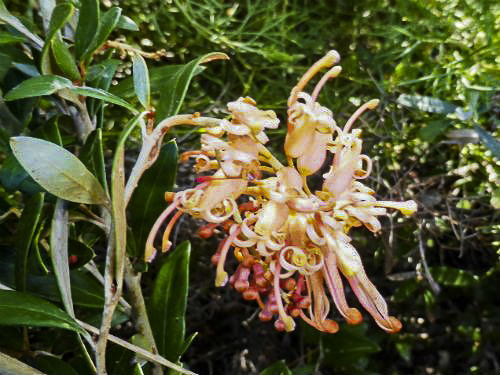
Grevillea ‘Apricot Charm’ is a spreading shrub reaching a height of 1.5 metres with a spread of about 2 metres. The leaves are about three centimetres long, dark green and glossy. The large flowers are held in pendulous clusters, apricot coloured and make their presence felt in winter and spring
Grevillea anethifolia
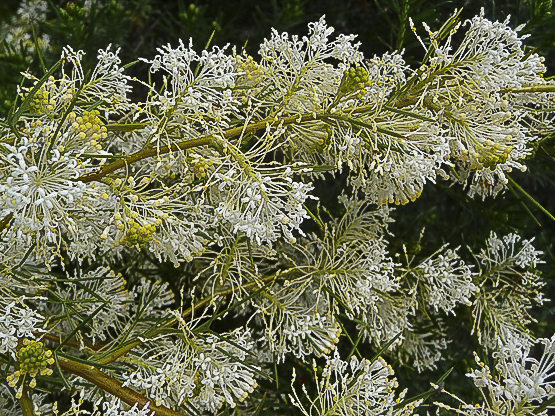
Grevillea anethifolia is known as the Spiny Cream Spider Flower and is a medium, spreading shrub. Our specimens reach a height of two metres with a similar spread. The flowers are creamy-white, conspicuous, profuse and sweetly perfumed.
Grevillea acanthifolia
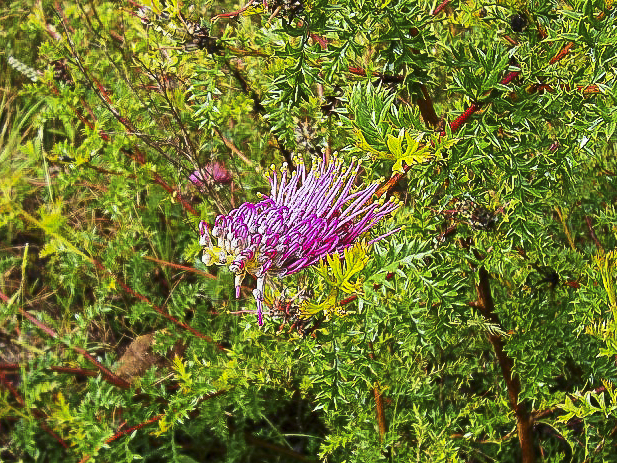
Grevillea acanthifolia is a spreading shrub that may reach a height of three metres with a spread of four metres. Judicious pruning will keep plants to a more manageable height and width. Divided leaves are bright green, stiff, prickly and up to 12 centimetres long. Grevillea acanthifolia carries pink, toothbrush-type flowers for most of the year.
Graptophyllum excelsum
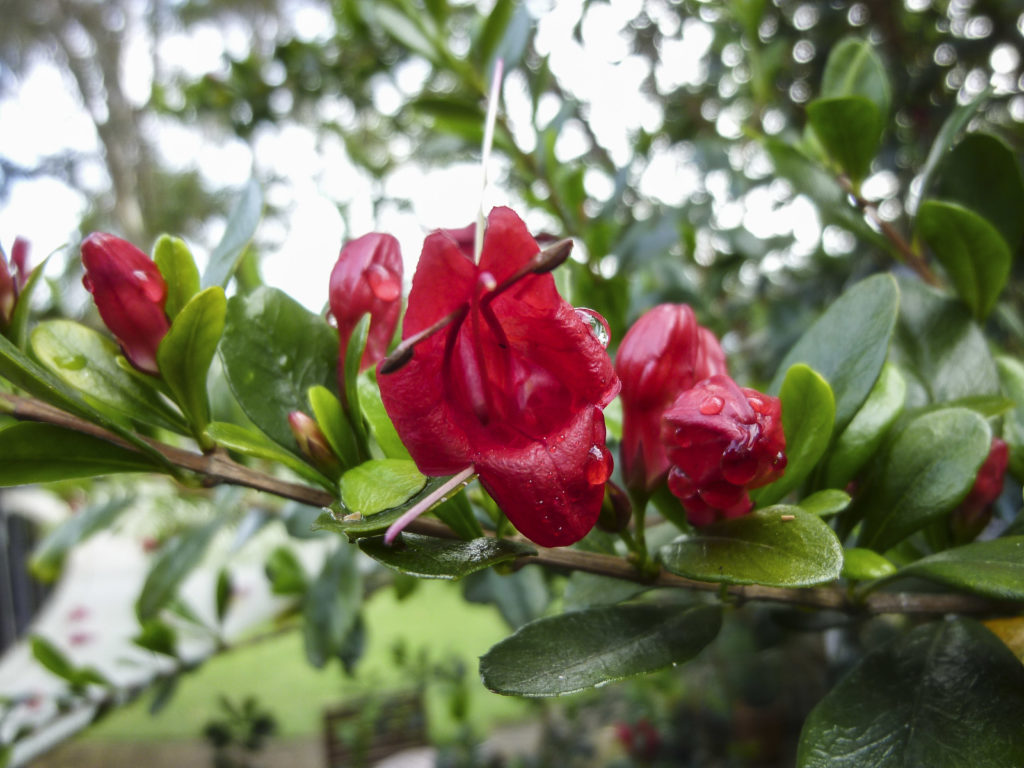
Graptophyllum excelsum is found along the eastern coast and ranges of Queensland. The natural habitat of Graptophyllum excelsum is north of Cairns to south of Gladstone but this versatile and hardy plant apparently can grow in Melbourne (or so some gardening books suggest) and is resistant to light frosts.
Goodenia ovata

Goodenia ovata is a member of the Goodeniaceae family and is known as the Hop Goodenia. There are 170 Goodenia species with only three occurring outside Australia. Plants may be an upright or spreading shrub that will reach a height of two metres.
Eucalyptus kruseana
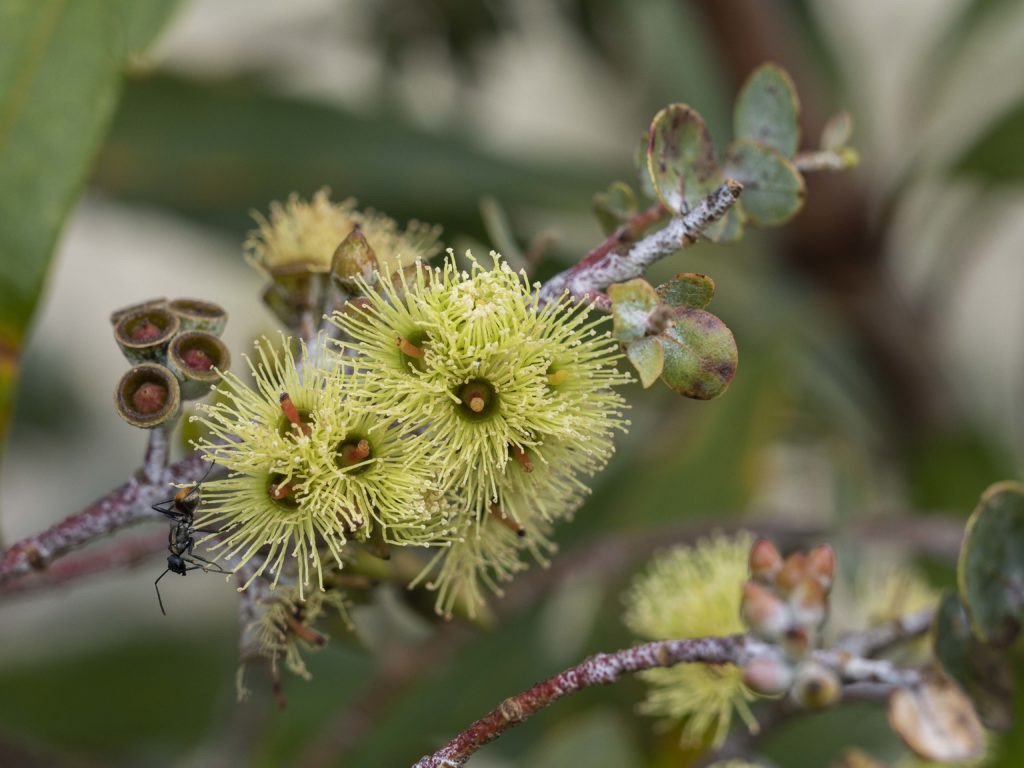
Eucalyptus kruseana would be one of the best eucalypts for cultivation in suburban gardens. Unpruned plants may become straggly. This is prevented, once plants are established, by cutting back each stem almost to ground level. This will encourage multi-stemmed (mallee) growth.
Eremophila ‘Thundercloud’
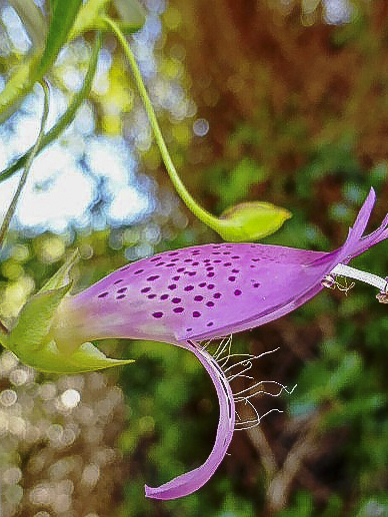
Eremophila ‘Thundercloud’ is one of the many cultivars of Eremophila maculata. “Thundercloud” has been available, from nurseries, since about 2010. Eremophila ‘Thundercloud’ is a small to medium shrub that in our cold climate garden reaches a height of 1.5 metres.
Eremophila ‘Summertime Blue’
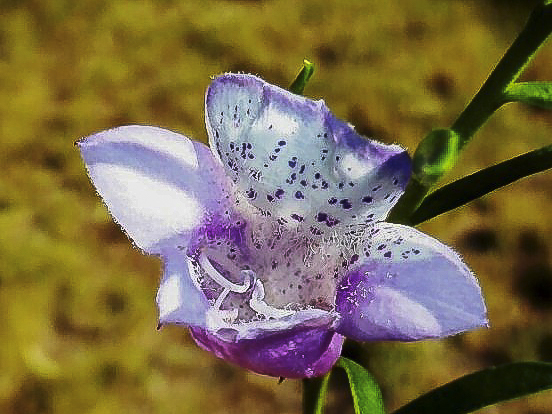
Eremophila ‘Summertime Blue’ is a naturally occurring hybrid whose parents are Eremophila divaricata and Eremophila polyclada. The hybrid originated in northwest Victoria on the floodplains of the Murray River.
Eremophila polyclada

Eremophila polyclada, the Flowering Lignum, grows in inland areas of all mainland Australian states except Western Australia. This species is a tangled, spreading shrub that reaches a height of three metres in our cold climate garden
Eremophila microtheca

Eremophila microtheca is a small, compact shrub reaching a height of 1.5 metres with a similar spread. Leaves are fine, narrow, hairy when young and becoming hairless with age. Foliage gives off an odour, when crushed, which may be objectionable to some gardeners.
Eremophila laanii
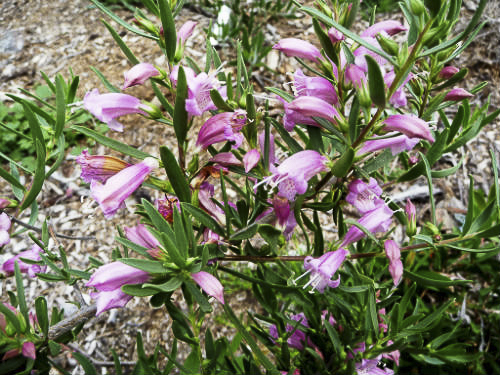
Eremophila laanii is a medium to tall shrub that may reach a height of four metres. Leaves have a succulent feel and are narrow, flat with a pointed tip. Flowers are white, cream or pink and two centimetres long. They are conspicuous and extremely profuse during the flowering period which extends from August to January.
Eremophila denticulata
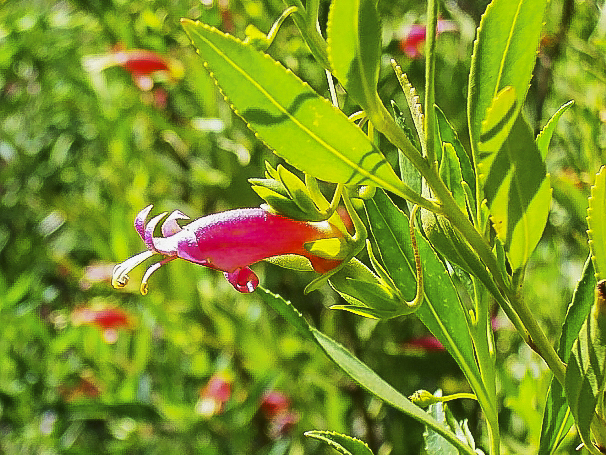
Eremophila denticulata is known as the Fitzgerald Emu Bush or Toothed Eremophila. The former name refers to the Fitzgerald River National Park, Western Australia, where this rare species occurs. Eremophila denticulata will grow into a shrub from 1 to 3 metres tall.
Eremophila calorhabdos
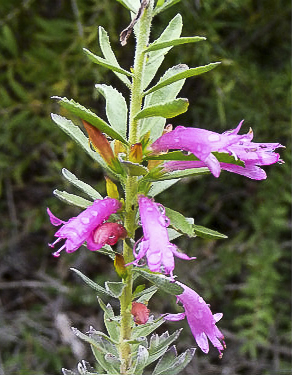
Eremophila calorhabdos, Red Rod is a two metre high shrub with upright growth habit. Before opening buds are orange-yellow then change to carmine when the flowers open. They are carried at the base of the leaves and appear from winter to summer. Honeyeaters visit the blooms. This is a beautiful emu bush with its columns of flowers. The visual impact of native cottage gardens and rockeries would benefit from the inclusion of a couple of Red Rods.
Eremophila bignoniiflora
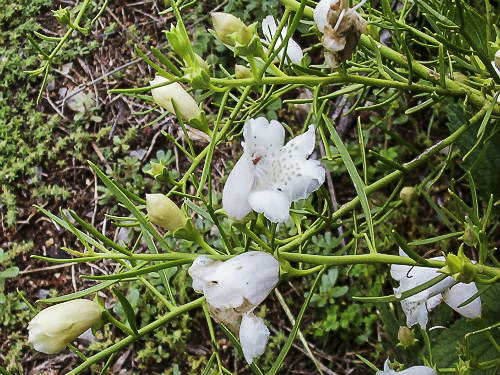
Eremophila bignoniiflora is a spreading, weeping shrub that may reach a height of five metres by almost the same width. The branches are smooth and sticky. Leaves are light green, long and strap-like. The flowers are large, tubular and usually cream with purple spots in the throat.
Eremophila ‘Beryl’s Blue’
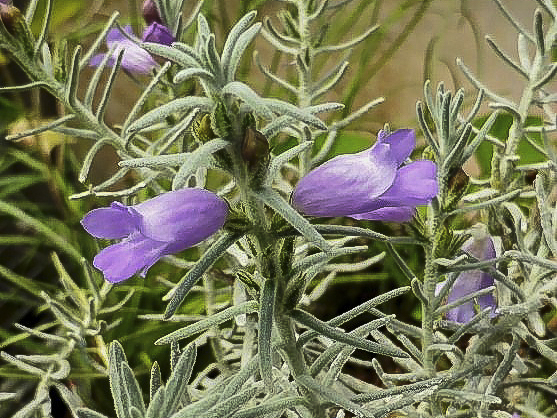
Eremophila ‘Beryl’s Blue’ is an outstanding shrub. The foliage shines like a beacon in the garden and the flowers add to the effect. Occasional tip pruning will improve foliage density. Both foliage and flowers are attractive features.
Dodonaea viscosa
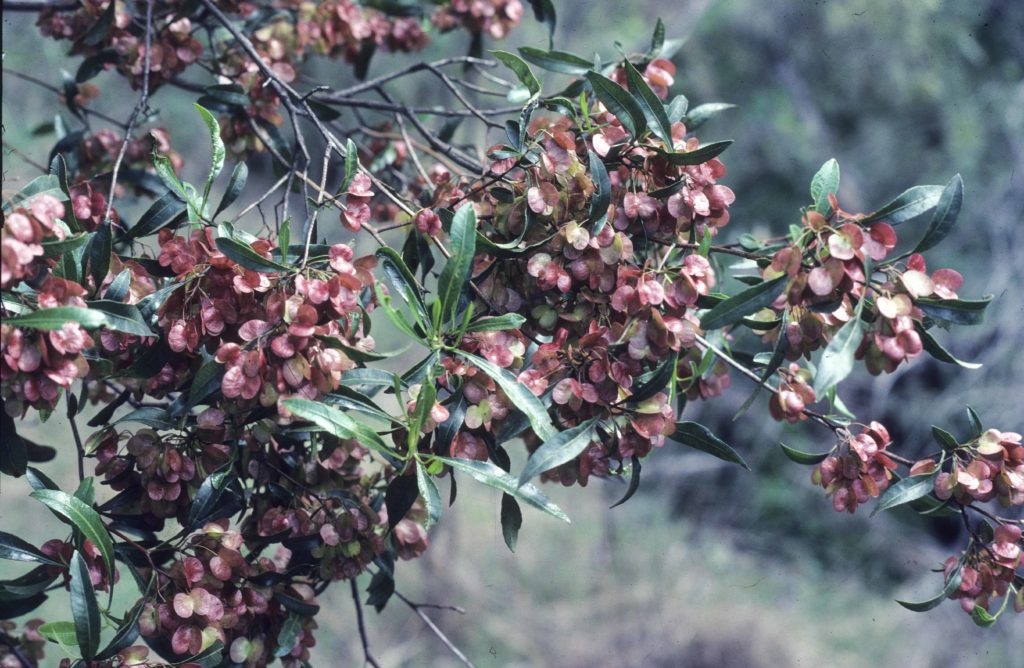
Dodonaea viscosa, the Sticky Hop Bush, is a tall multi-stemmed shrub reaching a height of four metres. The leaves are linear, sticky with a margin that may be entire, slightly wavy and slightly toothed. It was used by Aboriginal people to treat toothache, cuts and stingray stings. Dodonaeas were also used by early settlers to make beer (hence the common name).
Dodonaea boroniifolia

Dodonaea boroniifolia has both interesting foliage and colourful capsules. Reaching a height of 2-3 metres this species has pinnate leaves. The leaflets are dark green, sticky with lobed apex. Flowering extends from May to December. The 4-winged capsules that appear after flowering are an eye-catching purplish-red. The dark green foliage contrasts with the capsules.
Daviesia latifolia

Daviesia latifolia, the Hop Bitter-pea, is a medium, upright shrub that may reach a height of three metres. The large, leathery leaves are up to ten centimetres long, three centimetres wide with a network of veins and slightly twisted.
Darwinia citriodora
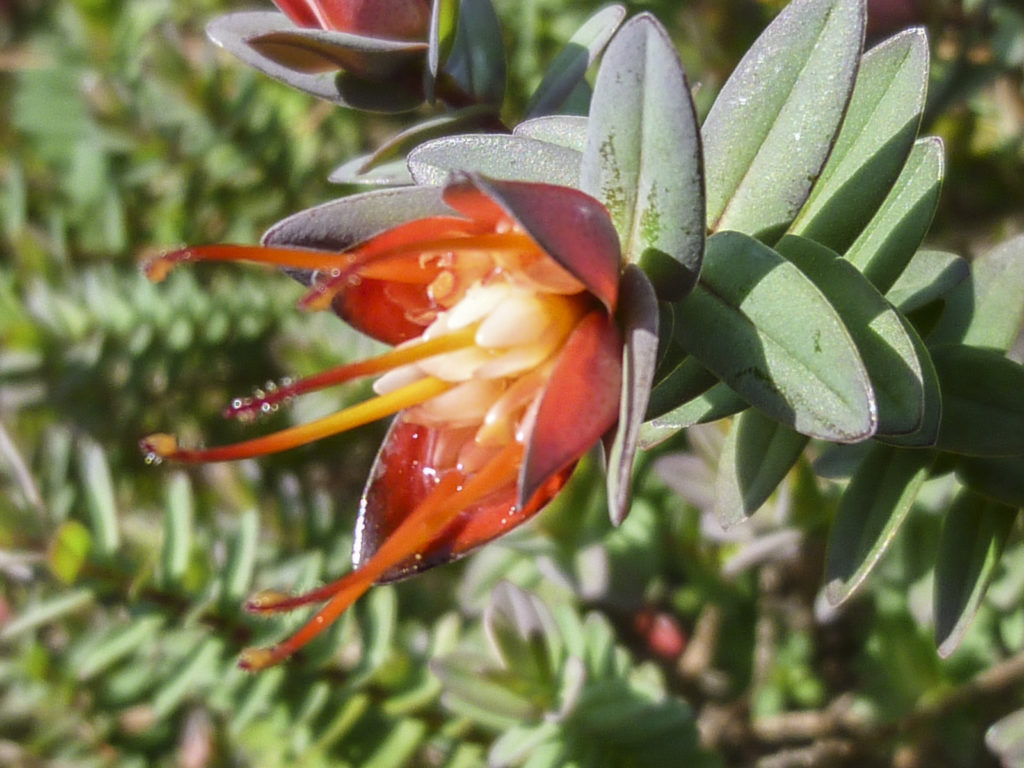
Darwinia citriodora, the Lemon-scented Myrtle, is a native of Western Australia and grows to about 1.5 metres tall with a similar spread, forming a compact, rounded shrub. The attractive leaves are rich green, 6 mm to 12 mm long, colouring during winter with traces of purple-red.
Crowea ‘Festival’
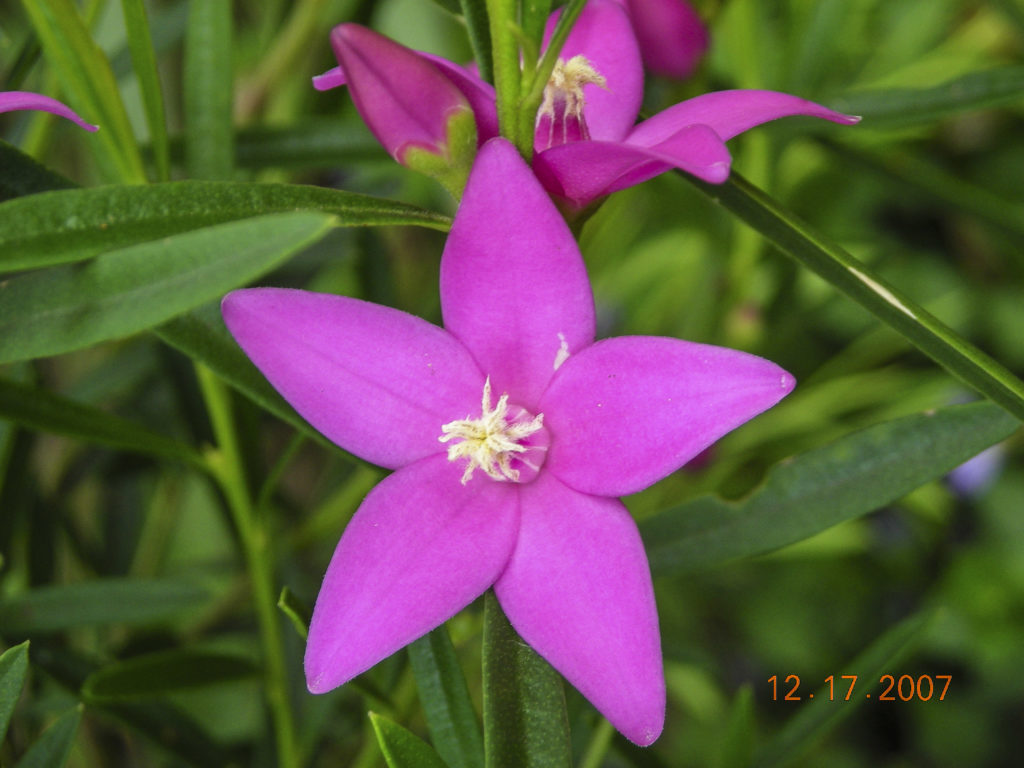
Crowea ‘Festival’ is a hybrid between Crowea exalata and Crowea saligna and was a chance seedling in the garden of past Australian Plant Society members, Arthur and Irene Cooper. I have been growing Crowea ‘Festival’ for many years in my garden in the northern Sydney suburb of Westleigh.
Correa reflexa

Correa reflexa is a species that occurs in every state except Western Australia. Growth habit, foliage shape and flower colour all differ dramatically across the range of this species. Perhaps in the future these differences will provide fertile ground for a botanist to split Correa reflexa into many new species.
Correa lawrenceana var. rosea
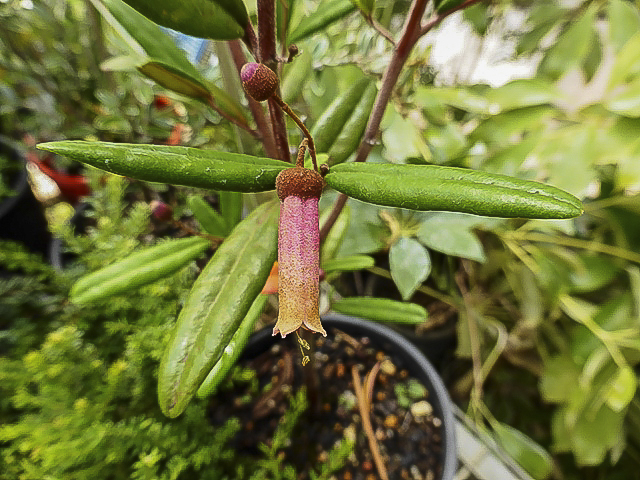
Correa lawrenceana var. rosea is a tall shrub that will reach a height of 3-4 metres. Dark green, narrow leaves are up to 60 millimetres long, shiny with a leathery texture above and hairy beneath. Tubular flowers are red, narrow and up to 20 millimetres long. Blooms appear in autumn and winter and help to light up our cold climate garden in these cooler months.
Correa glabra
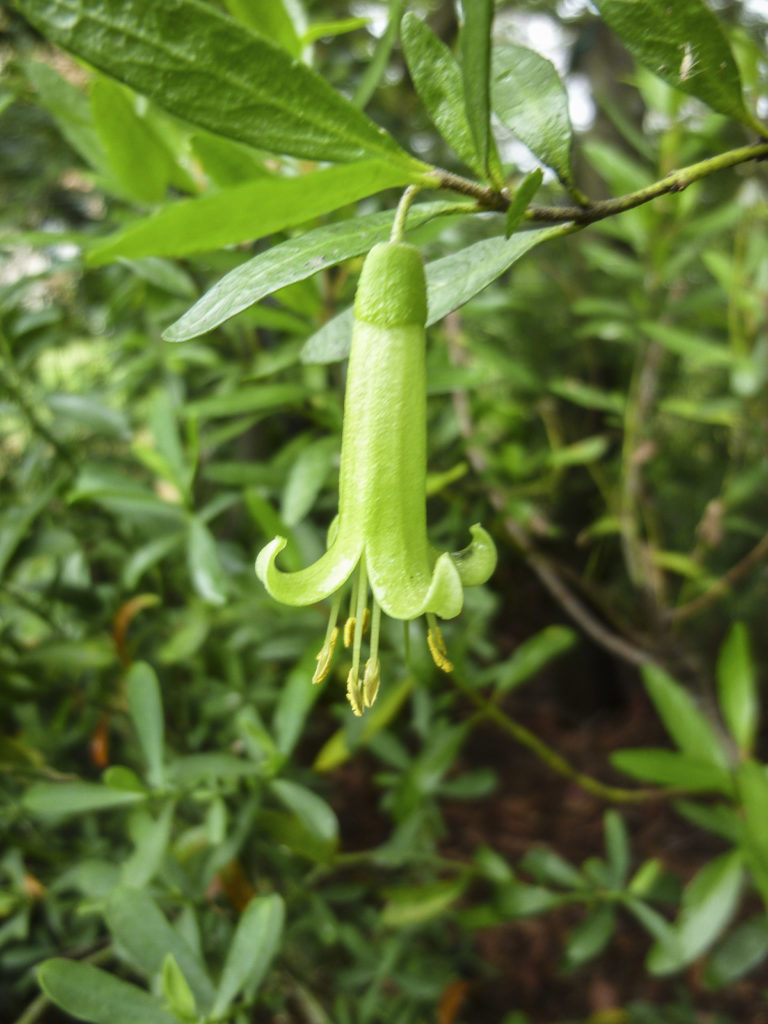
Correa glabra is a tall shrub, endemic to Australia (NSW, Queensland, Victoria, South Australia) with attractive, quite vibrant elliptic leaves, 1 to 4 cm long and 5 to 17 mm wide. They will grow in a variety of soil types as long as the soil is well drained. They are very ‘prune-able’ and shoot from old wood.
Correa ‘Coliban River’
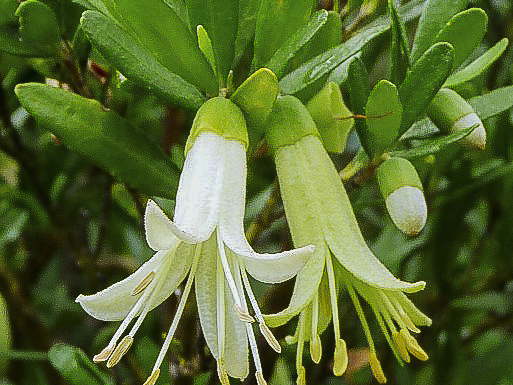
Correa ‘Coliban River’ is a dense shrub that, in our garden, reaches a maximum height of two metres. Narrow leaves are three centimetres long, glossy on top and paler below. Tubular flowers are two centimetres long, yellowish green with flared tips. The main flowering period extends from autumn through winter with sporadic flowering at other times. In autumn and winter our plants are covered in blooms for months.
Correa baeuerlenii

Correa baeuerlenii, the Chef’s Cap Correa, is a dense, rounded shrub reaching a height of two metres. We lightly prune our specimens and keep them to a dense 1.5 metres. Leaves are narrowly ovate, up to seven centimetres long, glossy, with prominent glands on each surface and slightly aromatic when crushed. Tubular flowers are greenish yellow, about three centimetres long, solitary and pendulous.
Correa alba
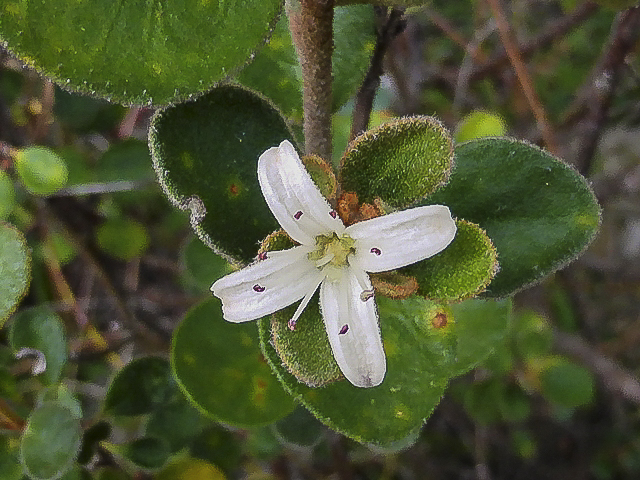
Correa alba is a rounded, dense shrub, growing to a heaight of about 2 metres by up to 1 metre wide. It has a purely coastal occurrence in NSW, growing very close to or on the beach or rocky headlands, south from Port Stephens, in patchy occurrences south along the coast. It has a patchy distribution along most of the Victorian coast and it is found along the north and east coasts of Tasmania as well as the islands of Bass Strait. It also grows along the South Australian coast from Mt. Gambier to Adelaide and Kangaroo Island.
Commersonia salviifolia

Commersonia salviifolia is a member of the Malvaceae family. It is a medium, spreading shrub. Leaves are up to 12 centimetres long, two centimetres wide, mid green above with a dense covering of white hairs beneath. Juvenile growth is white-hairy beneath.
Cassinia quinquefaria
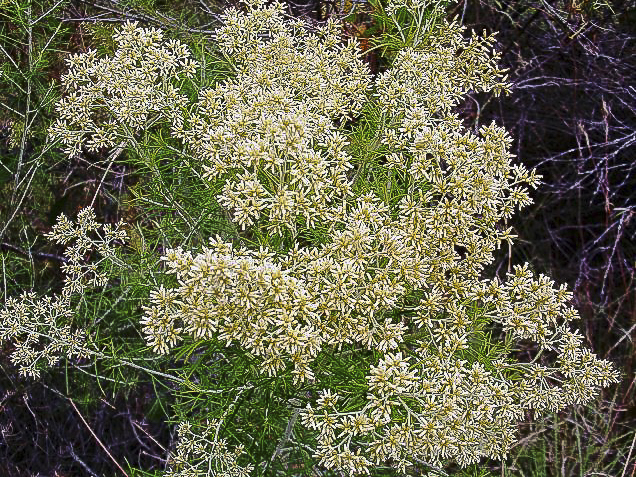
Cassinia quinquefaria is a member of Asteraceae (Daisy) family and grows into a shrub that reaches a height of two metres with a similar spread. Cough-bush, Dead-finish and Rosemary shrub are some common names.
Calytrix tetragona
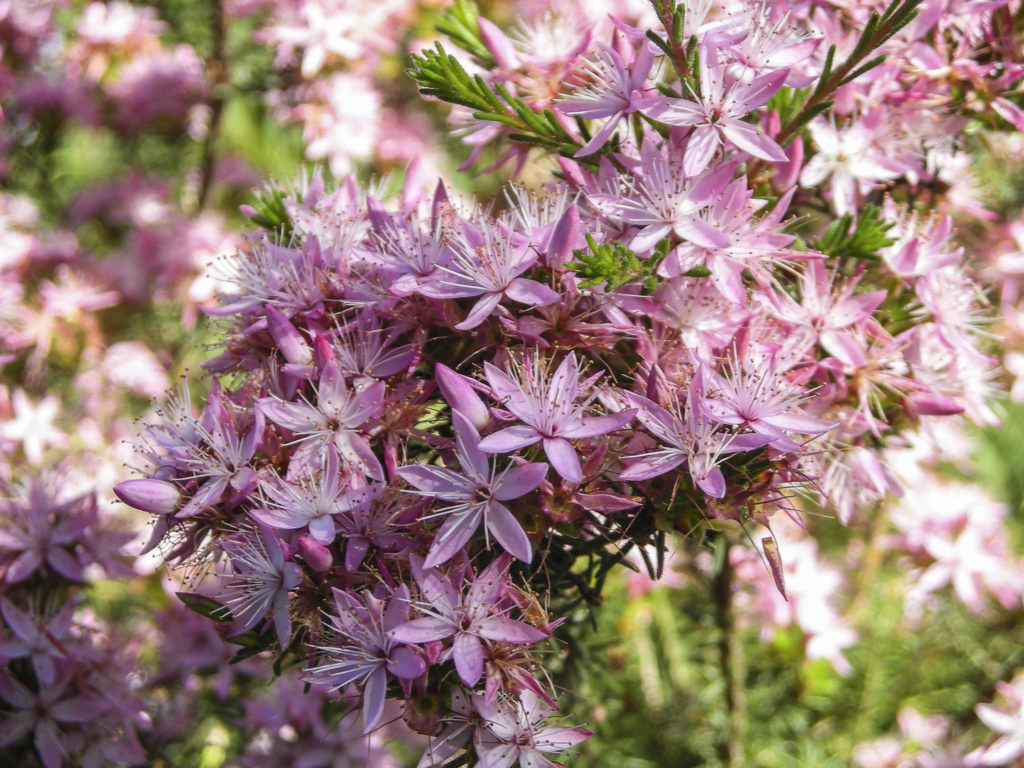
Calytrix tetragona is the most widespread member of the genus Calytrix which has about 75 species, all endemic to Australia. This species is found in woodland and forest in eastern and southern Australia.
Calothamnus rupestris

Calothamnus rupestris is known as the Cliff Net Bush or Mouse Ears. Net Bush is the common name applied to most Calothamnus. Calothamnus rupestris is a medium, erect shrub that has reached a height of two metres with a similar spread in our cold climate garden.
Callistemon subulatus
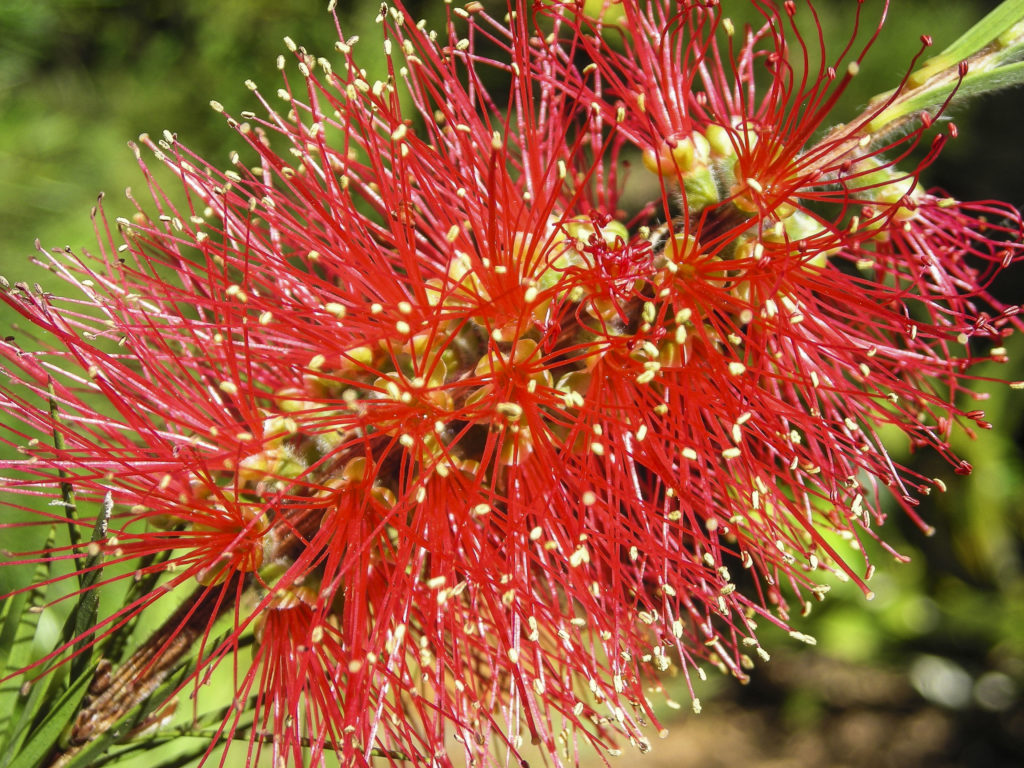
Callistemon subulatus grows along the banks of watercourses of coastal and tableland districts, south from Sydney to Victoria. In its natural habitat, they grow from one to sometimes 3 metres high. Callistemons are closely related to Melaleucas, which also have ‘bottlebrush’ shaped flower spikes. Botanists, especially those at the Australian National Botanic Gardens in Canberra are currently closely studying these plants to determine how they are best classified.
Callistemon serpentinus
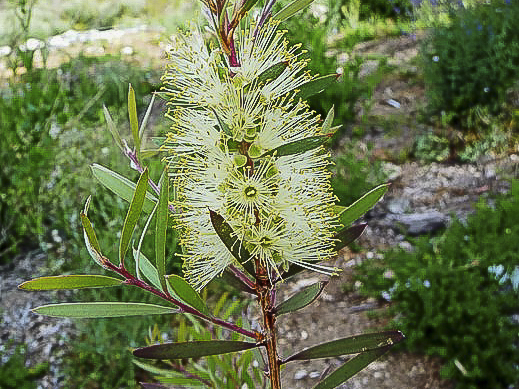
Callistemon serpentinus s known as the Wood’s Reef Bottlebrush and is an upright shrub that may reach a height of four metres. Our specimens are kept to a dense height of two metres by annual pruning. Yellow flower spikes are about six centimetres long and appear in late spring and early summer. Flower spikes are both prominent and conspicuous.
